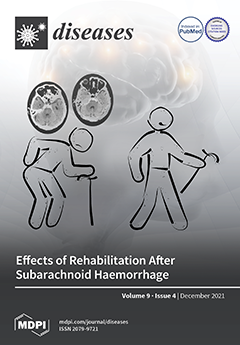Diseases, Volume 9, Issue 4 (December 2021) – 29 articles
In about 25% of patients with spontaneous subarachnoid hemorrhage, a bleeding source cannot be identified. A modified Rankin scale (mRs) was used to measure the influence on quality of life. An SF-36 questionnaire was used for long-term follow-up.
In short-term outcome, a significant improvement from discharge until follow-up was identified with subsequent rehabilitation, but not in the group without rehabilitation. If PM-SAH is compared to a standard population, a reduction in quality of life was identified by the SF-36 questionnaire. Even though there were better mRs at discharge for patients without subsequent rehabilitation, mRs of rehabilitants became nearly even. Patients with good mRs also reach a high HRQoL without rehabilitation. Therefore, subsequent rehabilitation should be recommended on an individual basis.
- Issues are regarded as officially published after their release is announced to the table of contents alert mailing list.
- You may sign up for e-mail alerts to receive table of contents of newly released issues.
- PDF is the official format for papers published in both, html and pdf forms. To view the papers in pdf format, click on the "PDF Full-text" link, and use the free Adobe Reader to open them.






